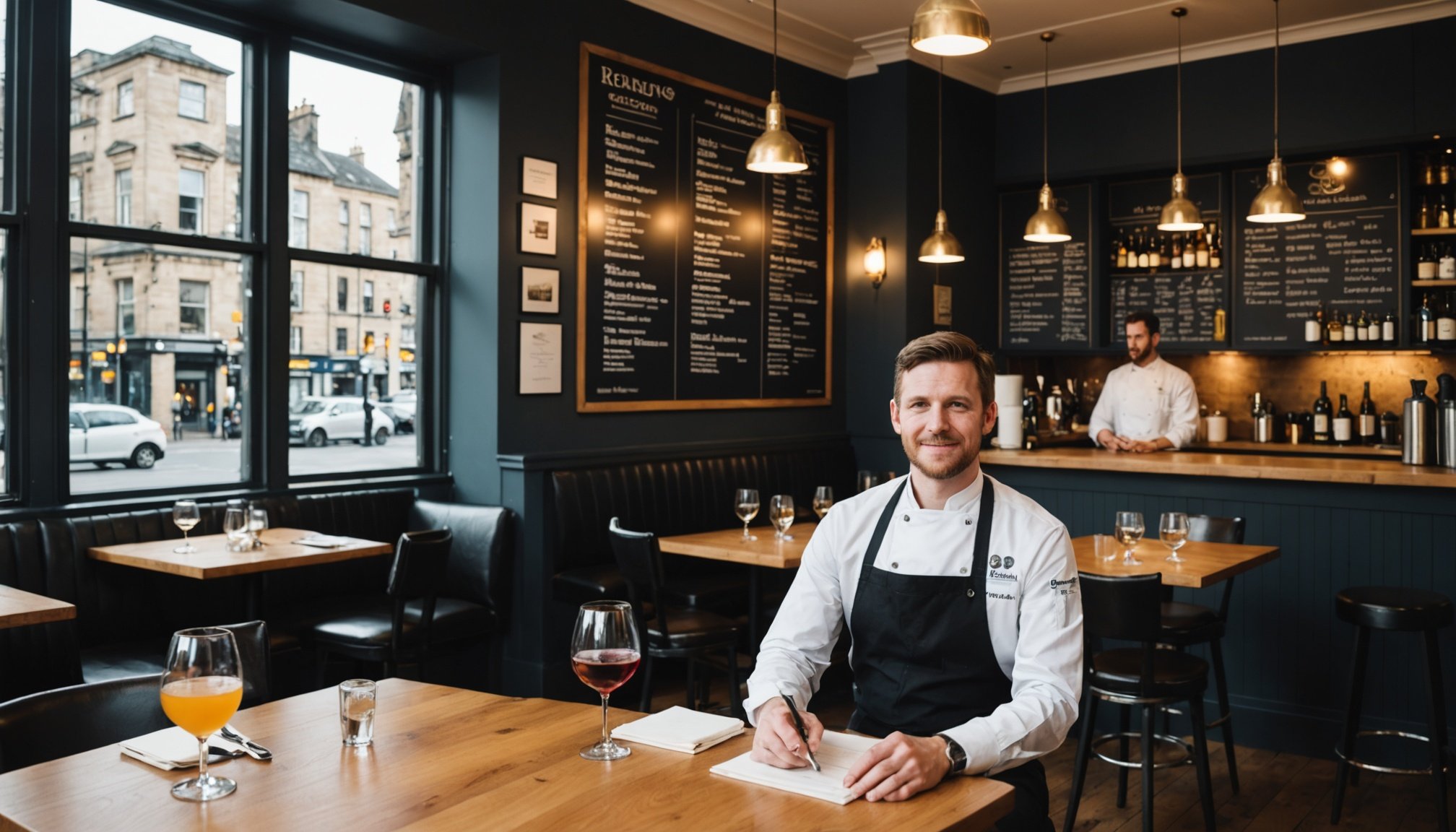Future Trends in Glasgow’s Culinary Industry
With evolving consumer preferences and advancing technology, the future of dining in Glasgow takes an exciting turn. Expect shifts in consumer behavior as diners become more health-conscious and environmentally aware. This pushes the culinary industry towards innovative, sustainable practices aligning with emerging food trends. Local chefs are exploring plant-based options and ethical sourcing, enhancing both the nutritional value and ethical appeal of their menus.
Technology plays a pivotal role in transforming dining experiences. Savvy restaurateurs leverage data to personalize offerings and streamline operations, catering to the modern diner’s love for tailored experiences. From using apps to improve service efficiency to implementing AI for menu suggestions, the possibilities are vast. This aligns perfectly with the growing trend of culinary industry innovations that focus on enhancing customer experience while maximizing operational efficiency.
Additional reading : Top commercial interior design trends to watch in 2025
Furthermore, data utilization will increasingly shape the food sector. Establishments integrating data analytics can anticipate demands and adapt swiftly, leading to more responsive and successful business strategies. With sustainability and personalization driving the future of dining in Glasgow, local businesses are well-poised to blend tradition with modernity. As these trends develop, both businesses and diners stand to gain from an industry eager to innovate and excel.
Overview of Glasgow’s Culinary Scene
The Glasgow culinary landscape is a vibrant tapestry of innovation and tradition, influenced by an array of food industry trends. Dining establishments throughout the city are pivoting towards environmentally conscious and health-oriented menu offerings. This shift reflects a broader change in consumer behaviors, where diners seek not just taste, but also sustainability and nutritional value.
Also read : Igniting Donor Passion: Digital Strategies for Bristol Non-Profits to Flourish
Glasgow’s food market is continually shaped by these emerging preferences, resulting in restaurants embracing plant-based alternatives and ethically sourced ingredients. Restaurateurs, understanding the need for differentiation, are employing data-driven dining strategies, allowing them to capture and respond to shifting demands effectively.
One significant trend in this regard is the application of innovation in restaurants. Advanced technologies are being used not just in kitchen operations but also in personalizing the dining experience. By harnessing data, eateries can craft bespoke menu items that cater to individual palettes, elevating the overall dining experience.
The stratification of Glasgow’s culinary scene into one that values tradition, while simultaneously pushing boundaries with technology and innovation, showcases the collective enthusiasm of the city’s restaurateurs to adapt and excel. This dynamic environment promises continuous growth and opportunity for local businesses and discerning diners looking for the future of gastronomy.
The Power of Data Analytics in Restaurants
Data analytics plays a transformative role in modern restaurants, significantly influencing menu creation and enhancing the overall customer experience. By leveraging data, restaurants can gain valuable customer insights, allowing them to tailor offerings to meet diners’ preferences effectively. This approach not only personalizes dining experiences but also streamlines operations, ensuring that every element of the dining process is tuned to deliver maximum satisfaction.
Menu optimization is a primary advantage of data-driven decision making. By analyzing consumption patterns and feedback, restaurants can craft dishes that resonate with their clientele, adjusting menus to reflect seasonal trends and popular choices. This strategic mode of operation, informed by analytics, aligns culinary offerings with customer desires, leading to increased patronage and repeat visits.
However, implementing data analytics in restaurants is not without its challenges. Many establishments face hurdles such as the high cost of technology, data integration issues, and a lack of analytical expertise. Overcoming these obstacles requires targeted investments and the adoption of scalable solutions that can adapt to varying business needs. As the dining industry evolves, embracing data analytics will be crucial for restaurants aiming to stay connected with their audience and thrive in a competitive landscape.
Case Studies of Successful Implementation
Delving into case studies provides insightful glimpses into successful strategies within the food industry. Data-driven restaurants leverage analytics, allowing precise customer insights and menu customization, enhancing both customer satisfaction and business growth.
Restaurant A: Revolutionizing Menu Offerings
Restaurant A exemplifies how data-driven decisions can revolutionize menus. Their swift shifts based on customer data ensure dishes align with seasonal preferences, boosting satisfaction and ingredient efficiency. Knowing what patrons prefer, Restaurant A proactively adjusts its offerings, maintaining relevance and excelling in customer service. By incorporating data analytics effectively, this establishment remains adaptable and favoured among diners, thriving in a competitive space.
Restaurant B: Personalization through Data
Restaurant B shines through custom menu items derived from data analysis. By tailoring experiences to individual preferences, the restaurant has fostered growth in repeat business, capitalizing on customer-specific insights to enhance recommendations and dining pleasures. This strategy not only strengthens loyalty but sets a benchmark in personalized service.
Restaurant C: Local Ingredients and Analytics
By utilizing analytics, Restaurant C partners with local producers, offering fresher dishes while supporting the community. This data-informed choice increases menu appeal and highlights the positive societal impact achieved when tech meets tradition. Emphasizing local produce resonates with conscientious diners, further solidifying Restaurant C’s market position.
Techniques for Analyzing Consumer Preferences
Analyzing consumer preferences is pivotal in crafting appealing menu offerings. Key metrics include customer demographics, buying patterns, and feedback, allowing thorough insights into their desires. Menu optimization becomes achievable as businesses identify popular dishes and tailor experiences accordingly.
Leveraging analytics techniques for the food industry involves harnessing surveys and real-time feedback. Surveys collect detailed information on tastes and expectations, while feedback provides a direct connection to understand diner satisfaction. This data is indispensable in refining menu items and fostering customer loyalty.
Technology plays a crucial role in data analysis within restaurants. Tools like CRM systems and AI-driven platforms analyze preferences, enabling restaurants to personalize experiences. Such technologies streamline the decision-making process, utilizing consumer preference analysis to offer dishes that align with diners’ tastes.
Operators should combine traditional market research with advanced analytics. While digital solutions provide precision in understanding consumer behavior, engaging directly with customers yields valuable qualitative insights. Employing tools like sentiment analysis and trend monitoring ensures menu selections remain relevant and dynamic in appealing to evolving tastes. By focusing on both innovative techniques and customer interaction, restaurants enhance their offerings, driving menu optimization that resonates deeply with patrons.
Examples of Customized Menus
The integration of customized dining experiences significantly elevates the food experience, as demonstrated by various restaurants employing analytics for personalized offerings. By examining real examples, one sees how data transforms ordinary menus into personalized restaurant offerings.
Unique Menu Offerings Based on Analytics
Consider a restaurant that uses data to craft an adaptive menu. By analysing consumer preferences, it introduces special dishes tailored to specific dietary needs and seasonal palates. This approach not only aligns menus with popular tastes but also incorporates local produce, further enriching the dining experience. These specialized menus cater to diners seeking novelty merged with personal touch, addressing individual tastes.
Enhancing Customer Engagement and Loyalty
Restaurants adopting personalization strategies witness a boost in customer engagement. Diners, receiving experiences customized to their preferences, often feel more inclined to revisit. Such adaptive menus not only increase satisfaction but also foster a sense of familiarity, enticing customers to become loyal patrons. This direct connection between personalized offerings and enhanced loyalty manifests in repeat visits, positively impacting business growth.
Balancing Tradition and Innovation
While customization is key, balancing traditional dishes with data-driven innovations is essential. By blending cherished local recipes with analytics-based novelties, restaurants maintain cultural relevance while meeting diverse consumer needs. This equilibrium ensures that menus remain both rooted in tradition and contemporary in approach, catering flawlessly to dynamic dining trends.
Benefits for Local Businesses and Customers
Data analytics in restaurants offers significant advantages for local businesses and diners alike, crafting a mutually beneficial dining ecosystem. Personalized menus, made possible through data-driven decision making, provide restaurants with the tools necessary to cater directly to customer tastes, driving not only satisfaction but also increased loyalty. Customers enjoy enhanced experiences with dishes that reflect their preferences, leading to higher levels of engagement and repeated patronage.
Implementing these insights allows establishments to adopt effective business growth strategies. By understanding consumer patterns, restaurants can optimize inventory and reduce waste, consequently boosting profitability. Such precise adaptation helps local businesses remain competitive and scalable, even in fluctuating markets. Additionally, restaurants exploring data analytics can expedite innovation in their product offerings, responding promptly to emerging trends and maintaining relevance.
The consistent application of data-driven strategies can significantly enhance customer satisfaction in dining. By anticipating needs and delivering consistently high-quality, curated meals, establishments foster strong relationships with their clientele, creating a devoted customer base. These tailored experiences transform the dining landscape in Glasgow, encouraging businesses to strive for excellence in both service delivery and culinary innovation. The dynamic between data and dining continues to evolve, showcasing the power of analytics in shaping Glasgow’s future gastronomic success.











